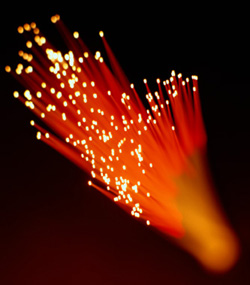A Clear Signal from Polarized Light

While a wide range of data courses constantly through fiber optic cables across the US, the options for encoding it with light are narrow, in one sense: Telecommunications rarely exploit the characteristic of light called polarization. Transmissions based on polarization–the orientation of light’s electric field–easily become garbled, thanks to vibrations and stresses on the fiberoptic lines. In the 4 March print issue of PRL, two physicists demonstrate a new way of encoding a message with polarization, using a so-called fiber ring laser, which twirls its light in an erratic but predictable way. With their technique, researchers could tap out tough-to-decipher messages without worrying that the signal will unravel en route.
Engineers can use schemes for encoding messages in the amplitude or wavelength of light, but a less distortion-prone way to use polarization would widen their options (and might let them send data faster). The problem is that compressed or bent fiberoptic lines change the polarization of a light signal as it travels to its recipient. And the amount of change can vary in time: Whenever snow falls in Nebraska or trucks cross a New York street, buried optical fibers alter subtly.
Greg VanWiggeren, now of Agilant Labs in Palo Alto, CA, and Rajarshi Roy, now of the University of Maryland in College Park, have developed a system to send polarization signals using an erbium-doped fiber ring laser. Such lasers tease light from erbium ions that have been mixed into ordinary glass bent into a ring, and they circulate light to amplify it, instead of bouncing it between mirrors as traditional lasers do. The laser sends a stream of constantly fluctuating light down a fiber that branches from the ring.
Although the polarization erratically fluctuates, it evolves predictably–in a way that reflects how the fiber ring twists the light inside it with each lap. The researchers could choose a set of filters that will exactly mimic the effect of an extra lap: Send in light of one polarization and the filters rotate it to the polarization that would emerge from the laser one cycle later.
These filters are an essential part of the team’s scheme for encoding polarization information in a new way, resistant to garbling and eavesdropping alike. To decipher the signal from any given laser would require a particular set of filters. By sending the arriving light stream down two paths of different lengths, and by putting filters at the end of the longer one, a person can constantly monitor whether the filters correctly predict the future output of the fluctuating laser. VanWiggeren and Roy showed that the sender can create a “1” by temporarily disturbing the laser in some way that changes its polarization, which causes the filters to fail at predicting the future. When the disturbance ceases, the filters succeed again, which the receiver interprets as a “0.” Polarization changes caused by imperfections in the line have no affect on the comparison made by the receiver, so they can’t thwart the transmission.
“I think it’s very clever,” says Matt Kennel of the University of California at San Diego. While reading the message does demand special knowledge (how to arrange the filters, for example), the communications probably aren’t secure in a mathematical sense, he says. Dan Gauthier of Duke University in Durham, NC, notes the technique’s potential for speed, which partly depends on how fast the laser fluctuates. So far that’s faster than is easily measured, Roy says, but theoretically the rate should be in the range of petahertz per second).
–Oliver Baker
Oliver Baker is a freelance science writer based in Davis, CA.


